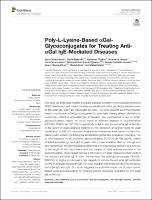| dc.contributor | Vall d'Hebron Barcelona Hospital Campus |
| dc.contributor.author | Olivera-Ardid, Sara |
| dc.contributor.author | Bello-Gil, Daniel |
| dc.contributor.author | Tuzikov, Alexander |
| dc.contributor.author | Araújo, Ricardo |
| dc.contributor.author | Ferrero Alves, Yara |
| dc.contributor.author | García Figueroa, Blanca Esther |
| dc.contributor.author | Labrador Horrillo, Moisés |
| dc.date.accessioned | 2022-09-06T12:38:00Z |
| dc.date.available | 2022-09-06T12:38:00Z |
| dc.date.issued | 2022-03 |
| dc.identifier.citation | Olivera-Ardid S, Bello-Gil D, Tuzikov A, Araujo RN, Ferrero-Alves Y, García Figueroa BE, et al. Poly-L-Lysine-Based αGal-Glycoconjugates for Treating Anti-αGal IgE-Mediated Diseases. Front Immunol. 2022 Mar;13:873019. |
| dc.identifier.issn | 1664-3224 |
| dc.identifier.uri | https://hdl.handle.net/11351/8039 |
| dc.description | Mice; Immunotherapy |
| dc.description.abstract | Anti-αGal IgE antibodies mediate a spreading allergic condition known as αGal-syndrome (AGS). People exposed to hard tick bites are sensitized to αGal, producing elevated levels of anti-αGal IgE, which are responsible for AGS. This work presents an immunotherapy based on polymeric αGal-glycoconjugates for potentially treating allergic disorders by selectively inhibiting anti-αGal IgE antibodies. We synthesized a set of αGal-glycoconjugates, based on poly-L-lysine of different degrees of polymerization (DP1000, DP600, and DP100), to specifically inhibit in vitro the anti-αGal IgE antibodies in the serum of αGal-sensitized patients (n=13). Moreover, an animal model for αGal sensitization in GalT-KO mice was developed by intradermal administration of hard tick’ salivary gland extract, mimicking the sensitization mechanism postulated in humans. The in vitro exposure to all polymeric glycoconjugates (5-10-20-50-100 µg/mL) mainly inhibited anti-αGal IgE and IgM isotypes, with a lower inhibition effect on the IgA and IgG, respectively. We demonstrated a differential anti-αGal isotype inhibition as a function of the length of the poly-L-lysine and the number of αGal residues exposed in the glycoconjugates. These results defined a minimum of 27 αGal residues to inhibit most of the induced anti-αGal IgE in vitro. Furthermore, the αGal-glycoconjugate DP1000-RA0118 (10 mg/kg sc.) showed a high capacity to remove the anti-αGal IgE antibodies (≥75% on average) induced in GalT-KO mice, together with similar inhibition for circulating anti-αGal IgG and IgM. Our study suggests the potential clinical use of poly-L-lysine-based αGal-glycoconjugates for treating allergic disorders mediated by anti-αGal IgE antibodies. |
| dc.language.iso | eng |
| dc.publisher | Frontiers Media |
| dc.relation.ispartofseries | Frontiers in Immunology;13 |
| dc.rights | Attribution 4.0 International |
| dc.rights.uri | http://creativecommons.org/licenses/by/4.0/ |
| dc.source | Scientia |
| dc.subject | Glicoconjugats |
| dc.subject | Al·lèrgia alimentària |
| dc.subject | Ratolins |
| dc.subject.mesh | Glycoconjugates |
| dc.subject.mesh | Food Hypersensitivity |
| dc.subject.mesh | Mice |
| dc.title | Poly-L-Lysine-Based αGal-Glycoconjugates for Treating Anti-αGal IgE-Mediated Diseases |
| dc.type | info:eu-repo/semantics/article |
| dc.identifier.doi | 10.3389/fimmu.2022.873019 |
| dc.subject.decs | glicoconjugados |
| dc.subject.decs | hipersensibilidad a los alimentos |
| dc.subject.decs | ratones |
| dc.relation.publishversion | https://doi.org/10.3389/fimmu.2022.873019 |
| dc.type.version | info:eu-repo/semantics/publishedVersion |
| dc.audience | Professionals |
| dc.contributor.organismes | Institut Català de la Salut |
| dc.contributor.authoraffiliation | [Olivera-Ardid S, Bello-Gil D, Ferrero-Alves Y] RemAb Therapeutics, Mòdul de Recerca B, Universitat Autònoma de Barcelona, Bellaterra, Spain. [Tuzikov A] Department of Chemical Biology of Glycans and Lipids, Shemyakin-Ovchinnikov Institute of Bioorganic Chemistry Russian Academy of Sciences (RAS), Moscow, Russia. [Araujo RN] Laboratório de Artrópodes Hematófagos, Departamento de Parasitologia, ICB/UFMG, Belo Horizonte, Brazil. [García Figueroa BE] MEGA: Asthma Inception and Progression Mechanisms, Complejo Hospitalario de Navarra (CHN), Pamplona, Spain. Instituto de investigación sanitaria de Navarra (IdiSNA), Pamplona, Spain. ARADyAL Research Network, Instituto de Salud Carlos III (ISCIII), Madrid, Spain. [Labrador-Horrillo M] ARADyAL Research Network, Instituto de Salud Carlos III (ISCIII), Madrid, Spain. Departament de Medicina, Universitat Autònoma de Barcelona, Bellaterra, Spain. Secció d’Al•lèrgia, Servei de Medicina Interna, Vall d’Hebron Hospital Universitari, Barcelona, Spain. Àrea de Malalties Immunomediades i Teràpies Innovadores, Vall d’Hebron Institut de Recerca (VHIR), Barcelona, Spain |
| dc.identifier.pmid | 35432370 |
| dc.identifier.wos | 000790897900001 |
| dc.rights.accessrights | info:eu-repo/semantics/openAccess |

